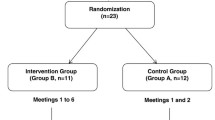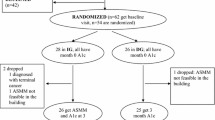Abstract
Self-management of insulin-dependent diabetes mellitus (IDDM) is dependent on a negative feedback loop of blood glucose (BG) fluctuations, which in turn directs treatment decisions to maintain normal BG. Although this feedback is typically accomplished by self-monitoring of blood glucose (SMBG), SMBG has limitations, and patients often rely on what their BG “feels” like. Two studies were performed to evaluate whether patients could learn to more accurately “feel”/discriminate their BG on the basis of internal cues or internal plus external BG cues. In Study I, BG Awareness Training significantly improved pre- to posttreatment BG estimation accuracy, relative to a control group. Study II replicated BG Awareness Training efficacy in improving BG estimation accuracy. Improvement in estimation accuracy was related only to initial accuracy; those who were initially less accurate improved the most. This improvement was represented in a 31% reduction in dangerous BG estimation errors and a 9% increase in accurate estimates. Resulting estimations were, however, still significantly less accurate than SMBG at the end of training.
Similar content being viewed by others
References
Clarke, W. L., Cox, D. J., Gonder-Frederick, L. A., Carter, W., & Pohl, S. (1987). Evaluating clinical accuracy of self blood glucose monitoring systems.Diabetes Care, 10 622–628.
Consensus statement on self monitoring of blood glucose. (1987).Diabetes Care, 10 95–99.
Cox, D. J., Clarke, W., Gonder-Frederick, L., Pohl, S., Hoover, C., Snyder, A., Zimbelman, L., Carter, W. R., Bobbitt, S., & Pennebaker, J. W. (1985), Accuracy of perceiving blood glucose in IDDM.Diabetes Care, 8 529–536.
Cox, D. J., Gonder-Frederick, L. A., Carter, W. R., Clarke, W., Bennett-Johnson, S., Rosenbloom, A., Bradley, C., & Moses, J. (1985). Symptoms and blood glucose levels in diabetics.Journal of the American Medical Association, 253 1558–1559.
Cox, D. J., Gonderick, L. A., Pohl, S., & Pennebaker, J. W. (1983). Reliability of symptom-blood glucose relationships among insulin-dependent adult diabetics.Psychosomatic Medicine, 45 357–360.
Davis, M., Eshelman, E. R., & McKay, M. (1980).The relaxation and stress reduction workbook. Richmond, CA: New Harbinger Publications.
Dedrick, R. (1987). Determining the accuracy of data from self-monitoring of blood glucose.Diabetes, 132A.
Dhenin, G. (1978).Aviation medicine: Physiology and human failure. London: William Clowes.
Freund, A., Bennett-Johnson, S., Rosebloom, A. L., Alexander, B., Apperson, & Hansen, C. (1986). Subjective symptoms: Blood glucose estimation and blood glucose concentrations in adolescents with diabetes.Diabetes, 33, 70A.
Gonder-Frederick, L. A. (1987). Relationship between moods, symptoms and blood glucose level in insulin-dependent diabetic patients.Health Psychology.
Gonder-Frederick, L. A., & Cox, D. J. (1986). Behavioral response to perceived hypoglycemic symptoms: A report and some suggestions.Diabetes Educator, 12 105–109.
Gonder-Frederick, L. A., Cox, D. J., Pennebaker, J. W., & Bobbitt, S. A. (1986). Blood glucose symptom beliefs of diabetic patients: Accuracy and implications.Health Psychology, 5 327–342.
Greenstandt, L., Shapiro, D., & Whitehead, R. (1986). Blood pressure discrimination.Psychophysiology, September, 500–509.
Holmes, C. S., Hayford, J. T., Gonzalez, J. L., Weydert, J. A. (1985). A survey of cognitive functioning at different glucose levels in diabetic persons.Diabetes Care, 6 180–185.
Holmes, C. S., Koepke, K. M., & Thompson, R. G. (1986). Simple versus complex neuropsychological impairments during three blood glucose levels.Psychoneuroendocrinology.
Holmes, C. S., Koepke, K. M., Thompson, R. G., Gyves, P. W., & Weydert, J. A. (1984). Verbal fluency and naming performance in Type I diabetes at different blood glucose concentrations.Diabetes Care, 6 454–459.
Krall, L. (1978).Joslin diabetes manual. Philadelphia: Lea Febiger.
Moses, J. L., & Bradley, C. (1985). Accuracy of subjective blood glucose estimation by patients with insulin-dependent diabetes.Biofeedback and Self-Regulation, 10 301–314.
Nathan, P. E. (1982). Blood alcohol level discrimination and diagnosis. InEncyclopedic handbook of alcoholism. (pp. 64–71). New York: Gardner Press.
O'Connell, K. A., Hamera, E. K. Knapp, T. M., Cassmeyer, V. L., Eak, G. A., & Fox, M. A. (1984). Symptom use and self-regulation in Type II diabetes.Advances in Nursing Science, 6 19–28.
Pennebaker, J. W., Cox, D. J., Gonder-Frederick, L. A., Wunsch, M. G., Evans, W. S., & Pohl, S. (1981). Physical symptoms related to blood glucose in insulin-dependent diabetics.Psychosomatic Medicine, 43 489–500.
Pohl, S., Gonder-Frederick, L. A., Cox, D. J., & Evans, W. (1985). Self-measurement of blood glucose: Clinical significance of patient-generated measurements.Diabetes Care, 88 617–619.
Schiffrin, A., & Belmonte, M. (1982). Multiple daily self-glucose monitoring: Its essential role in long-term glucose control in insulin-dependent diabetic patients treated with pumps and multiple subcutaneous injections.Diabetes Care, 5 479–484.
Surwit, R. S., & Feinglos, M. N. (1983). The effects of relaxation on glucose tolerance in non-insulin dependent diabetes mellitus.Diabetes Care, 7 203–204.
Vidergar, L. J., Lee, R. M., & Goldman, M. S. (1983). Discrimination of systolic blood pressure.Biofeedback and Self-Regulation, 8 45–61.
Wing, R. R., Epstein, L. H., Lamparksi, D., Hagg, S. A., Nowalk, M. P., & Scott, N. (1985). Accuracy in estimating fasting blood glucose levels by patients with diabetes.Diabetes Care, 7 476–478.
Author information
Authors and Affiliations
Additional information
This research was supported by NIH grants AM282880, AM24177, AM22125, and RR00847 and by the Ames Company. The authors express their appreciation for the contribution made by trainers Leslie Butterfield and Linda Zimbelman, by the nursing staff at the University of Virginia's Clinical Research Center and the Diabetes and Nutrition Unit, and by Dr. James May from the Medical College of Virginia in soliciting subjects. We would also like to thank Andrea Snyder for her assistance.
Rights and permissions
About this article
Cite this article
Cox, D.J., Carter, W.R., Gonder-Frederick, L.A. et al. Blood glucose discrimination training in insulin-dependent diabetes mellitus (IDDM) patients. Biofeedback and Self-Regulation 13, 201–217 (1988). https://doi.org/10.1007/BF00999170
Issue Date:
DOI: https://doi.org/10.1007/BF00999170




